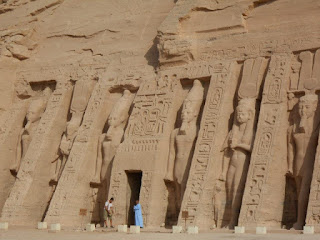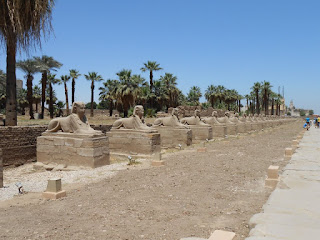 The Abu Simbel Temple is actually two individual temples, both rock cut structures, and both built during the reign of King Ramses II sometime in the 1200 B.C. time period. One temple is dedicated to King Ramses II, and the second temple is dedicated to his beloved wife Queen Nefertari. She was his first and principal wife, and he cherished her above all other. Many ancient Egypt temples were built because of devotion in this fashion. We also had to cross the desert at four in the morning in coach convoy, to avoid hijackers just to see this amazing structure. The desert was eerily quiet, no birds singing. Not a peep! The carvings and artwork that decorate both structures of the Abu Simbel Temple are incredible. Hand carved pillars, wall paintings, carvings, statues, and much more delight anyone who sees them. This artwork is thousands of years old, and very delicate. In 1964 the two structures of Abu Simbel Temple were cut into many different pieces, and both temples were moved further away from the rising water of Lake Nasser. The structures were moved to a location sixty five meters above the original spot, and two hundred meters further back from the shoreline.
The Abu Simbel Temple is actually two individual temples, both rock cut structures, and both built during the reign of King Ramses II sometime in the 1200 B.C. time period. One temple is dedicated to King Ramses II, and the second temple is dedicated to his beloved wife Queen Nefertari. She was his first and principal wife, and he cherished her above all other. Many ancient Egypt temples were built because of devotion in this fashion. We also had to cross the desert at four in the morning in coach convoy, to avoid hijackers just to see this amazing structure. The desert was eerily quiet, no birds singing. Not a peep! The carvings and artwork that decorate both structures of the Abu Simbel Temple are incredible. Hand carved pillars, wall paintings, carvings, statues, and much more delight anyone who sees them. This artwork is thousands of years old, and very delicate. In 1964 the two structures of Abu Simbel Temple were cut into many different pieces, and both temples were moved further away from the rising water of Lake Nasser. The structures were moved to a location sixty five meters above the original spot, and two hundred meters further back from the shoreline.The Sofitel Legend Old Cataract Hotel, also known as the Old Cataract Hotel, is a historic British colonial-era 5-star luxury resort hotel located on the banks of the River Nile in Aswan, Egypt. It was built by Thomas Cook. Its guests have included Tsar Nicholas II, Winston Churchill, Howard Carter, Margaret Thatcher, Jimmy Carter, Princess Diana, Queen Noor and Agatha Christie, who set portions of her novel Death On The Nile at the hotel. The 1978 film of the novel was shot at the hotel, one of my favourite films.
 Dam is
an embankment dam built across the Nile at Aswan, Egypt between 1898
and 1902. The High Dam was constructed between 1960 and 1970, and has had
a significant effect on the economy and culture of
Egypt.to control floods, provide water for irrigation, and generate hydro-electricity were
seen as pivotal to Egypt's industrialization
Dam is
an embankment dam built across the Nile at Aswan, Egypt between 1898
and 1902. The High Dam was constructed between 1960 and 1970, and has had
a significant effect on the economy and culture of
Egypt.to control floods, provide water for irrigation, and generate hydro-electricity were
seen as pivotal to Egypt's industrializationBefore the dams were built, the Nile flooded every year during late summer, when water flowed down the valley from its East African drainage basin. These floods brought high water and natural nutrients and minerals that annually enriched the fertile soil along the flood plain and delta; this had made the Nile valley ideal for farming since ancient times. Because floods vary, in high-water years the whole crop might be wiped out, while in low-water years widespread drought and famine occasionally occurred. As Egypt's population grew and conditions changed, both a desire and ability developed to control the floods, and thus both protect and support farmland and the economically important cotton crop. With the reservoir storage provided by the Aswan dams, the floods could be lessened and the water stored for later release.
Our Captain navigating the cruise boat through the Nile.
On the Falooka's little children row up to the boats and sing songs for a few pennies from the tourists in the boats. The trip to Elephant Island, so called because the huge stones look like elephants. We also had a peaceful sail through the reeds around the Nile gave up a wonderful scene of local birds and wildlife. We drifted past the edge of the sahara desert with my feeling trailing in the Niles very cool and refreshing water. Apparently dangling your feet over the side of a Falooka boat with your feet in the water is supposed to bring you good luck and a healthy and happy life. So that's good to know.
Nubian House -The Nubians are a non-Arab Muslim population who lived in the geographical region known as Nubia in southern Egypt and northern Sudan. One hundred and twenty thousand Nubians were relocated beginning in 1964 because their villages were inundated by the Aswan High Dam Lake. Some argue that the name Nubians derives from a word in the Nubian language meaning slaves, but others say that the ancient Egyptian word nab meant gold and that the Ancient Egyptians used that term to refer to the Nubian Valley because of the gold mines nearby.
Egyptian Market at Luxor takes up several streets near the Luxor temple. It is a joy to walk through, as it is mostly pedestrian and is a welcome respite from the horse and carriages on the main streets. This market really feels like an old souk and the visitor is taken back in time. It is covered with a wooden trellis, shading people from the sun. Many of the shops offer the same items, so the wise buyer shops around and looks for the best price. One can often bargain better after going to several stores.
Elephantine Island and beyond the Edge of the Sahara Desert.
Horse and carriage ride up to Edfu was frightening, having to ride through the city and be harassed by street sellers whilst trapped in the huge traffic jams.The temple of Edfu is the largest temple dedicated to Horus and Hathor of Dendera, Goddess of the sky, dance, love, beauty, joy, motherhood, foreign lands, mining, music and fertility. It was the centre of several festivals sacred to Horus. Each year, Hathor travelled south from her temple at Dendera to visit Horus at Edfu the event marked their sacred marriage was the occasion of a great festival and pilgrimage.
The bright colours of a gift shops can draw you in and once you find a merchant you like, sit down, have some tea, and begin the game of bargaining. It can feel like you are becoming a part of the family. Buying something as simple as a cotton galabeya can take several hours, as you try on almost every single galabeya in the store, and then move on to items that they think you may want as gifts for friends and family, but sometimes the bartering can become tiresome and annoying.
Isis Temple at Aswan.
 |
| Another example of a Nubian House near Aswan |
Old 1930's boat used to film Death on the Nile by Agatha Christie. I loved that film more than all the other Agatha Christie adaptations of her novels and although we weren't able to go and look around this traditional paddle river boat, the interior of our modern Nile boat was decorated very much with the feel and style of the art deco 30's. Lovely.
Sahara Desert from the plane.The Sahara is the world’s largest hot desert and one of the harshest environments on the planet. It is third largest desert overall after Antarctica and the Arctic, which are cold deserts.At 3.6 million square miles (9.4 million square kilometers), the Sahara, which is Arabic for "The Great Desert," engulfs most of North Africa. The desert covers large sections of Algeria, Chad, Egypt, Libya, Mali, Mauritania, Morocco, Niger, Western Sahara, Sudan and Tunisia. In other words - ITS BIG!!!
Alison's Website:http://www.alisonkershaw.com/book_lycan_lamia.php







































